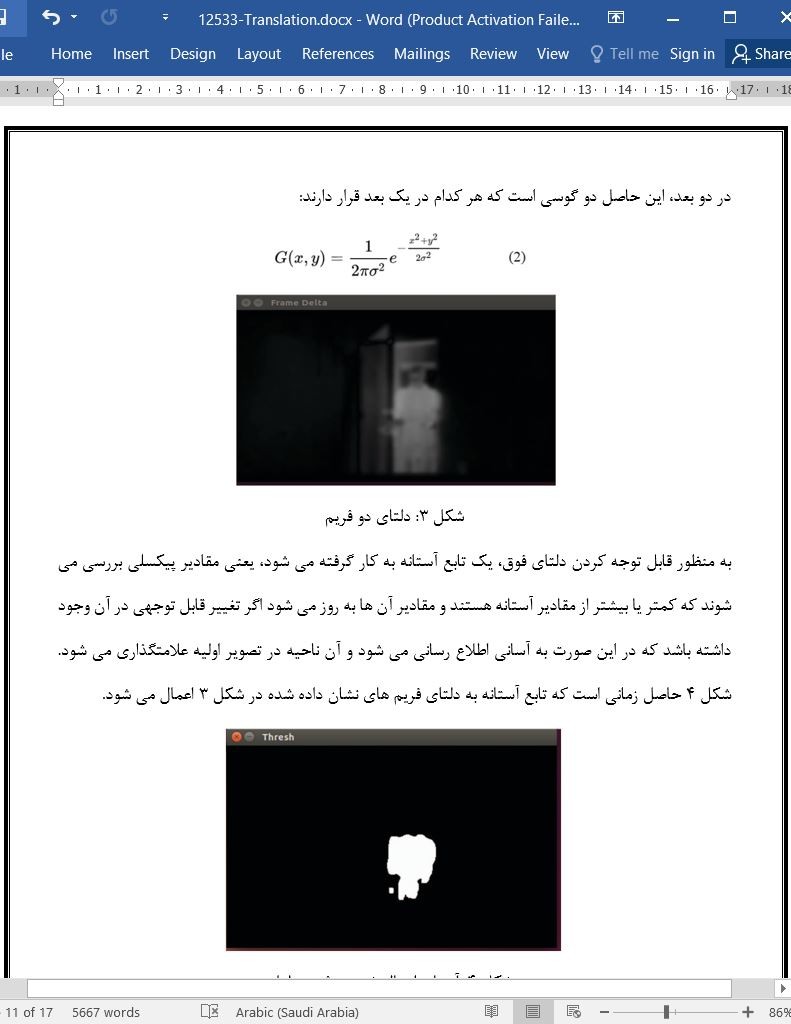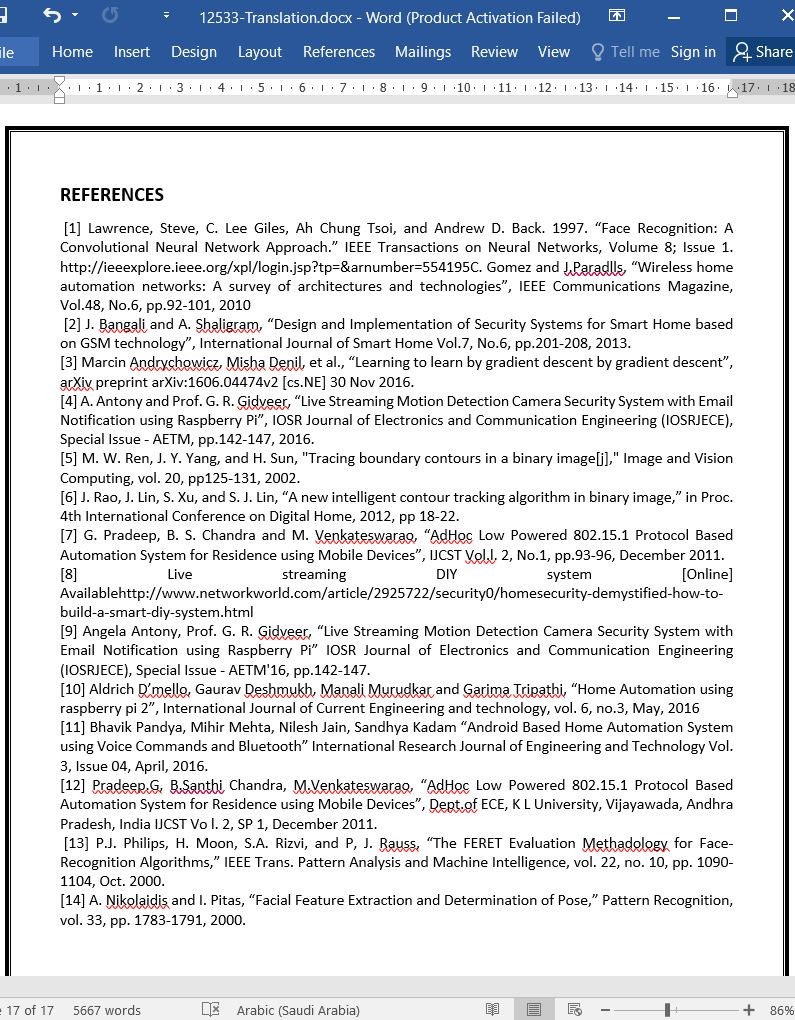
دانلود مقاله امنیت با استفاده از پردازش تصویر و شبکه های عصبی پیچشی عمیق
چکیده
ایمنی از مواردی است که تمامی افراد نگران آن هستند. نقض امنیت مکان های خصوصی به تهدیدی تبدیل شده است که هر فردی تمایل دارد آن را از بین ببرد. سیستم های سنتی امنیتی هنگامی که یک نقض امنیتی را شناسایی می کنند، زنگ های هشداردهنده خود را فعال می کنند. با این حال، به کارگیری پردازش تصویر همراه با یادگیری عمیق با استفاده از شبکه های عصبی پیچشی (کانولوشنی) برای تشخیص و دسته بندی تصویر در شناسایی یک نقض به روشی ارتقاء یافته کمک می کند و در نتیجه سبب افزایش امنیت به میزان بسیار زیادی می شود. این به دلیل قابلیت آن در استخراج ویژگی های پیچیده از تصاویر با استفاده الگوریتم های دقیق و پیچیده تشخیص چهره و بدن است. نرخی که در آن یادگیری ماشین و به ویژه یادگیری عمیق تبدیل می شود، بسیار زیاد است. با استفاده از چنین فناوری، انتقال سیستم ها و مدل های موجود به سطح بعدی گام عظیمی در راستای پیشرفت ها در هر حوزه علم و فناوری است. چنین روندی در حوزه رایانه نیز وجود دارد. این دو به یکدیگر پیوسته و در حوزه امنیت مورد استفاده قرار می گیرند که منجر به دستیابی به نتایج بهتری نسبت به آنچه که تصور می گردید می شود که هدف این مقاله نیز می باشد.
1. مقدمه
فناوری مورد استفاده در امن سازی مکان های بسیار مهم در سال های اخیر تغییرات بسیار زیادی داشته است و این تغییر همچنان در سال های آینده نیز ادامه دارد. امنیت مقوله بسیار مهمی به ویژه در رابطه با برنامه های هوشمند است. مفهوم جدید و در حال ظهور امنیت هوشمند روشی مناسب، راحت و ایمن را برای ایجاد امنیت در حوزه های با حساسیت بالا فراهم می کند [1]. به طور معمول هدف سیستم های امنیتی حفاظت از یک مکان در برابر نقض و نفوذ از طریق ارسال اطلاع رسانی به شکل آلارم های هشدار دهنده در زمان نقض است. با این، سیستم امنیتی پیشنهادی می تواند مزیت های بسیاری را در مقایسه با سیستم های متداول ارائه کند که در ادامه این مقاله مورد بررسی قرار می گیرند.
این مقاله بر این موضوع تمرکز می کند که امنیت در مکان های بسیار حساس و خصوصی همانند محلی که دارای ارزش زیادی است یا داده های حساسی در آن ذخیره شده است، با توسعه سیستم های هوشمند می تواند بسیار تاثیرگذارتر باشد؛ این سیستم های هوشمند قابلیت اجرا همراه با سطوح کارآمدی را دارند که توسط انسان یا حتی دیگر سیستم های امنیتی متداول نیز قابل دستیابی نمی باشند. این سیستم شامل دو ماژول است که در سطح سخت افزاری تعریف می شود و دربرگیرنده میکروکنترلر Raspberry Pi همراه با حسگرهای محدودی است که به آن متصل شده است و همچنین میکروکنترلر Arduino همراه با قابلیت های سیستم جهانی برای ارتباطات سیار (GSM) و سیستم موقعیت یابی جهانی (GPS) است که همراه با یکدیگر در محل اجرا نصب می شوند. این دو ماژول از طریق شبکه محلی با یکدیگر ارتباط برقرار می کنند و بر بستر شبکه عمومی راه دور با کاربرن در ارتباط هستند.
7. نتیجه گیری و کار آتی
بهبودهای صورت گرفته در این سیستم با استفاده از OpenFace و طبقه بندی کننده آن قابل انجام است. OpenFace به ما در دستیابی به 128 اندازه گیری از چهره کمک می کند و به عنوان یک ورودی به طبقه بندی کننده ارسال می کند. توجه به اندازه گیری های تصاویر که قبلاً انجام شده است مهم است. طبقه بندی کننده نزدیک ترین تطبیق با صورت را بررسی می کند. این کار با استفاده از مدل FaceNet گوگل که می تواند نتایج بهتری تولید کند قابل بهبود است. FaceNet می تواند دقتی در حدود 99.63 درصد را تولید کند.
Abstract
Safety has, for a long time, been one big thing everyone is concerned about. Security breach of private locations has become a threat that everyone intends to eliminate. The traditional security systems trigger alarms when they detect a security breach. However, the usage of image processing coupled with deep learning using convolutional neural networks for image identification and classification helps in identifying a breach in an enhanced fashion thereby increasing security furthermore to a great extent. This is due to its capability to extract complex features from the images using accurate and advanced face and body detection algorithms. The rate at which machine learning, especially deep learning, is transitioning is very high. The use of such technology in taking the existing systems and models to the next level would be a great step towards advancements in every field of science and technology. The same goes with computer vision. These two coupled and brought together to be used in the field of security results in achieving a lot more than what is imagined to be possible and this paper aims to do the same.
I. INTRODUCTION
Technology used in securing highly important places has changed a lot since the last few years and will continue to change in the coming years. Security is very important when it comes down to smart applications. The new and emerging concept of smart security offers a convenient, comfortable, and safe way for securing highly sensitive areas [1]. Security systems used conventionally aim to protect a place from a breach by sending a notification in the form of a triggered alarm at the time of breach. However, the proposed security system offers many more benefits when compared to the conventional systems which are discussed in detail as we go further ahead into the implementation and working of this system.
This paper focuses on how security at locations considered very sensitive and private such as a location where highly valuable or sensitive data is stored can be made much more effective by deploying intelligent systems that are capable of performing with efficiency levels that cannot be achieved by a human or even other traditional security systems. This system comprises of two modules defined at the hardware level which includes a Raspberry Pi Microcontroller with a few sensors connected to it and an Arduino Microcontroller with Global System for Mobile Communications (GSM) and Global Positioning System (GPS) capabilities installed together at the area of deployment. These two modules communicate with each other on the local network and together communicate with the users on the remote public network.
VII. CONCLUSION AND FUTURE WORK
Improvement to this system can be done using the OpenFace and the classifier it offers. OpenFace helps us to get the 128 measurements of the face and that is sent as an input to the classifier. Looking at all the measurements of the images which are measured before and the classifier will check with the closest match of the face. This can be further enhanced using the FaceNet model of Google which can produce better results. FaceNet was able to produce an accuracy of about 99.63%.
چکیده
1. مقدمه
2. انگیزه
3. بررسی مقالات
4. کار پیشنهادی
5. پیاده سازی و تحلیل سیستم پیشنهادی
6. نتایج و بحث
7. نتیجه گیری و کار آتی
منابع
Abstract
1. INTRODUCTION
2. MOTIVATION
3. LITERATURE SURVEY
4. PROPOSED WORK
5. IMPLEMENTATION AND ANALYSIS OF PROPOSED SYSTEM
6. RESULTS AND DISCUSSION
7. CONCLUSION AND FUTURE WORK
REFERENCES
- اصل مقاله انگلیسی با فرمت ورد (word) با قابلیت ویرایش
- ترجمه فارسی مقاله با فرمت ورد (word) با قابلیت ویرایش، بدون آرم سایت ای ترجمه
- ترجمه فارسی مقاله با فرمت pdf، بدون آرم سایت ای ترجمه



